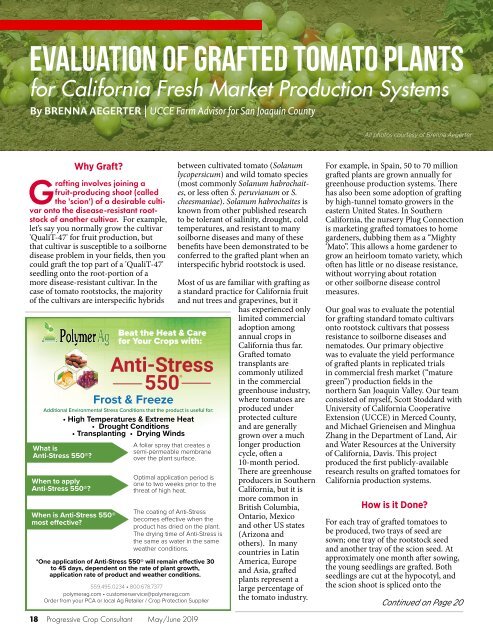PCC_MayJun_2019_e
Create successful ePaper yourself
Turn your PDF publications into a flip-book with our unique Google optimized e-Paper software.
Evaluation of Grafted Tomato Plants<br />
for California Fresh Market Production Systems<br />
By BRENNA AEGERTER | UCCE Farm Advisor for San Joaquin County<br />
All photos courtesy of Brenna Aegerter<br />
Why Graft?<br />
Grafting involves joining a<br />
fruit-producing shoot (called<br />
the 'scion') of a desirable cultivar<br />
onto the disease-resistant rootstock<br />
of another cultivar. For example,<br />
let’s say you normally grow the cultivar<br />
'QualiT-47' for fruit production, but<br />
that cultivar is susceptible to a soilborne<br />
disease problem in your fields, then you<br />
could graft the top part of a 'QualiT-47'<br />
seedling onto the root-portion of a<br />
more disease-resistant cultivar. In the<br />
case of tomato rootstocks, the majority<br />
of the cultivars are interspecific hybrids<br />
Additional Environmental Stress Conditions that the product is useful for:<br />
What is<br />
Anti-Stress 550®?<br />
When to apply<br />
Anti-Stress 550®?<br />
Frost & Freeze<br />
• High Temperatures & Extreme Heat<br />
• Drought Conditions<br />
• Transplanting • Drying Winds<br />
When is Anti-Stress 550®<br />
most effective?<br />
Beat the Heat & Care<br />
for Your Crops with:<br />
Anti-Stress<br />
550 ®<br />
A foliar spray that creates a<br />
semi-permeable membrane<br />
over the plant surface.<br />
Optimal application period is<br />
one to two weeks prior to the<br />
threat of high heat.<br />
*One application of Anti-Stress 550® will remain effective 30<br />
to 45 days, dependent on the rate of plant growth,<br />
application rate of product and weather conditions.<br />
559.495.0234 • 800.678.7377<br />
polymerag.com • customerservice@polymerag.com<br />
Order from your PCA or local Ag Retailer / Crop Protection Supplier<br />
between cultivated tomato (Solanum<br />
lycopersicum) and wild tomato species<br />
(most commonly Solanum habrochaites,<br />
or less often S. peruvianum or S.<br />
cheesmaniae). Solanum habrochaites is<br />
known from other published research<br />
to be tolerant of salinity, drought, cold<br />
temperatures, and resistant to many<br />
soilborne diseases and many of these<br />
benefits have been demonstrated to be<br />
conferred to the grafted plant when an<br />
interspecific hybrid rootstock is used.<br />
Most of us are familiar with grafting as<br />
a standard practice for California fruit<br />
and nut trees and grapevines, but it<br />
has experienced only<br />
limited commercial<br />
The coating of Anti-Stress<br />
becomes effective when the<br />
product has dried on the plant.<br />
The drying time of Anti-Stress is<br />
the same as water in the same<br />
weather conditions.<br />
adoption among<br />
annual crops in<br />
California thus far.<br />
Grafted tomato<br />
transplants are<br />
commonly utilized<br />
in the commercial<br />
greenhouse industry,<br />
where tomatoes are<br />
produced under<br />
protected culture<br />
and are generally<br />
grown over a much<br />
longer production<br />
cycle, often a<br />
10-month period.<br />
There are greenhouse<br />
producers in Southern<br />
California, but it is<br />
more common in<br />
British Columbia,<br />
Ontario, Mexico<br />
and other US states<br />
(Arizona and<br />
others). In many<br />
countries in Latin<br />
America, Europe<br />
and Asia, grafted<br />
plants represent a<br />
large percentage of<br />
the tomato industry.<br />
For example, in Spain, 50 to 70 million<br />
grafted plants are grown annually for<br />
greenhouse production systems. There<br />
has also been some adoption of grafting<br />
by high-tunnel tomato growers in the<br />
eastern United States. In Southern<br />
California, the nursery Plug Connection<br />
is marketing grafted tomatoes to home<br />
gardeners, dubbing them as a “Mighty<br />
‘Mato”. This allows a home gardener to<br />
grow an heirloom tomato variety, which<br />
often has little or no disease resistance,<br />
without worrying about rotation<br />
or other soilborne disease control<br />
measures.<br />
Our goal was to evaluate the potential<br />
for grafting standard tomato cultivars<br />
onto rootstock cultivars that possess<br />
resistance to soilborne diseases and<br />
nematodes. Our primary objective<br />
was to evaluate the yield performance<br />
of grafted plants in replicated trials<br />
in commercial fresh market (“mature<br />
green”) production fields in the<br />
northern San Joaquin Valley. Our team<br />
consisted of myself, Scott Stoddard with<br />
University of California Cooperative<br />
Extension (UCCE) in Merced County,<br />
and Michael Grieneisen and Minghua<br />
Zhang in the Department of Land, Air<br />
and Water Resources at the University<br />
of California, Davis. This project<br />
produced the first publicly-available<br />
research results on grafted tomatoes for<br />
California production systems.<br />
How is it Done?<br />
For each tray of grafted tomatoes to<br />
be produced, two trays of seed are<br />
sown; one tray of the rootstock seed<br />
and another tray of the scion seed. At<br />
approximately one month after sowing,<br />
the young seedlings are grafted. Both<br />
seedlings are cut at the hypocotyl, and<br />
the scion shoot is spliced onto the<br />
Continued on Page 20<br />
18 Progressive Crop Consultant May/June <strong>2019</strong>


















